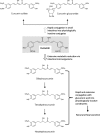The fallacy of enzymatic hydrolysis for the determination of bioactive curcumin in plasma samples as an indication of bioavailability: a comparative study
- PMID: 31684927
- PMCID: PMC6829936
- DOI: 10.1186/s12906-019-2699-x
The fallacy of enzymatic hydrolysis for the determination of bioactive curcumin in plasma samples as an indication of bioavailability: a comparative study
Abstract
Background: Numerous health benefits have been demonstrated for curcumin which is extracted from turmeric (Curcuma longa L). However, due to its poor absorption in the free form in the gastrointestinal tract and rapid biotransformation, various formulations have been developed to enhance its bioavailability. Previous studies indicate that the free form of curcumin is more bioactive than its conjugated counterparts in target tissues. Most curcumin pharmacokinetics studies in humans designed to assess its absorption and bioavailability have measured and reported total (free plus conjugated) curcumin, but not free, bioactive curcumin in the plasma because enzymatic hydrolysis was employed prior to its extraction and analysis. Therefore, the bioavailability of free curcumin cannot be determined.
Methods: Eight human subjects (4 male, 4 female) consumed a single dose of 400 mg curcumin in an enhanced absorption formulation, and blood samples were collected over 6 h. Plasma was treated either with or without glucuronidase/sulfatase prior to extraction. Curcumin and its major metabolites were analyzed using HPLC-tandem mass spectrometry. In addition, the literature was searched for pharmacokinetic studies involving curcumin using PubMed and Google Scholar, and the reported bioavailability data were compared based on whether hydrolysis of plasma samples was used prior to sample analysis.
Results: Hydrolysis of blood plasma samples prior to extraction and reporting the results as "curcumin" obscures the amount of free, bioactive curcumin and total curcuminoids as compared to non-hydrolyzed samples. As a consequence, the data and biological effects reported by most pharmacokinetic studies are not a clear indication of enhanced plasma levels of free bioactive curcumin due to product formulations, leading to a misrepresentation of the results of the studies and the products when enzymatic hydrolysis is employed.
Conclusions: When enzymatic hydrolysis is employed as is the case with most studies involving curcumin products, the amount of free bioactive curcumin is unknown and cannot be determined. Therefore, extreme caution is warranted in interpreting published analytical results from biological samples involving ingestion of curcumin-containing products.
Trial registration: ClinicalTrails.gov, trial identifying number NCT04103788 , September 24, 2019. Retrospectively registered.
Keywords: Bioactive curcumin; Curcumin glucuronide; Curcumin sulfate; Enzymatic hydrolysis.
Conflict of interest statement
The following authors declare that they have no conflicts of interest to report (HGP, CYOC, LRB, JJ, and SDR). SJS and LRB serve as a consultant for Boston Biopharm Inc. KJR is employed by Stratum Nutrition.
Similar articles
-
Incomplete Hydrolysis of Curcumin Conjugates by β-Glucuronidase: Detection of Complex Conjugates in Plasma.Mol Nutr Food Res. 2020 Mar;64(6):e1901037. doi: 10.1002/mnfr.201901037. Epub 2020 Jan 29. Mol Nutr Food Res. 2020. PMID: 31962379 Free PMC article.
-
Pharmacokinetics of a Single Dose of Turmeric Curcuminoids Depends on Formulation: Results of a Human Crossover Study.J Nutr. 2021 Jul 1;151(7):1802-1816. doi: 10.1093/jn/nxab087. J Nutr. 2021. PMID: 33877323 Free PMC article. Clinical Trial.
-
Comparative Oral Absorption of Curcumin in a Natural Turmeric Matrix with Two Other Curcumin Formulations: An Open-label Parallel-arm Study.Phytother Res. 2017 Dec;31(12):1883-1891. doi: 10.1002/ptr.5931. Epub 2017 Oct 13. Phytother Res. 2017. PMID: 29027274 Clinical Trial.
-
Beyond Yellow Curry: Assessing Commercial Curcumin Absorption Technologies.J Am Coll Nutr. 2015;34(4):347-58. doi: 10.1080/07315724.2014.950392. Epub 2015 Apr 9. J Am Coll Nutr. 2015. PMID: 25856323 Free PMC article. Review.
-
Review: bioavailability and efficacy of 'free' curcuminoids from curcumagalactomannoside (CGM) curcumin formulation.Nutr Res Rev. 2024 Jun;37(1):14-31. doi: 10.1017/S0954422423000033. Epub 2023 Jan 19. Nutr Res Rev. 2024. PMID: 36655498 Review.
Cited by
-
Biomedical Applications and Bioavailability of Curcumin-An Updated Overview.Pharmaceutics. 2021 Dec 7;13(12):2102. doi: 10.3390/pharmaceutics13122102. Pharmaceutics. 2021. PMID: 34959384 Free PMC article. Review.
-
Improving Curcumin Bioavailability: Current Strategies and Future Perspectives.Pharmaceutics. 2021 Oct 17;13(10):1715. doi: 10.3390/pharmaceutics13101715. Pharmaceutics. 2021. PMID: 34684008 Free PMC article. Review.
-
Advancements in curcuminoid formulations: An update on bioavailability enhancement strategies curcuminoid bioavailability and formulations.Open Life Sci. 2025 Jul 18;20(1):20251112. doi: 10.1515/biol-2025-1112. eCollection 2025. Open Life Sci. 2025. PMID: 40688407 Free PMC article. Review.
-
Tetrahydrocurcumin Ameliorates Skin Inflammation by Modulating Autophagy in High-Fat Diet-Induced Obese Mice.Biomed Res Int. 2021 Jun 14;2021:6621027. doi: 10.1155/2021/6621027. eCollection 2021. Biomed Res Int. 2021. PMID: 34222477 Free PMC article.
-
A novel solvent-free co-grinding preparation improves curcumin bioavailability in healthy volunteers: A single-center crossover study.Heliyon. 2023 Jan 5;9(1):e12829. doi: 10.1016/j.heliyon.2023.e12829. eCollection 2023 Jan. Heliyon. 2023. PMID: 36685407 Free PMC article.
References
-
- Kocaadam B, Sanlier N. Curcumin, an active component of turmeric (Curcuma longa), and its effects on health. Crit Rev Food Sci Nutr. 2015. 10.1080/10408398.2015.1077195. - PubMed
Publication types
MeSH terms
Substances
Associated data
Grants and funding
LinkOut - more resources
Full Text Sources
Other Literature Sources
Medical
Research Materials


